Pharma’s R&D lab of the future: Building a long-lasting innovation engine
Modernizing biopharma R&D labs is important for improving research productivity and ensuring the sustainable replenishment of drug pipelines
Jeff Morgan
Raveen Sharma
Andrew Bolt
Seshamalini Srinivasan
Wendell Miranda
Dimple Jobanputra
As biopharmaceutical organizations face mounting pressure to accelerate scientific discovery and sustain their drug pipelines, investments in lab-of-the-future initiatives are delivering tangible results.1 According to a Deloitte Center for Health Solutions’ survey of 104 biopharma research and development executives, 53% of respondents reported increased laboratory throughput, while 45% saw a reduction in human error, 30% achieved greater cost efficiencies, and 27% noted faster therapy discovery as a direct result of lab modernization efforts (see About the study).
These measurable improvements underscore the transformative impact of digital technologies, such as automation, artificial intelligence, advanced data integration, R&D productivity, and innovation. With the industry approaching an inflection point, organizations that prioritize lab modernization are not only streamlining scientific workflows but also potentially positioning themselves to maintain a competitive edge and sustainably replenish their pipelines in an increasingly challenging environment.2
The urgency for transformation is being driven by the anticipated loss of exclusivity for an unprecedented number of high-value assets. By 2030, patents for 190 drugs—including 69 current blockbusters—are likely to expire, putting $236 billion in sales at risk.3 As organizations race to fill gaps in their pipelines, deal premiums for external assets have surged.4 In this high-stakes environment, biopharma organizations have recognized that strengthening internal innovation capabilities is crucial for sustainable pipeline replenishment.5
Through the lab of the future—a digitally enabled, highly automated research environment powered by AI, robotics, and cloud computing—organizations can streamline scientific workflows, improve multimodal data management, and accelerate internal innovation. Such a lab environment could enable organizations to reduce trial and error in experimentation and identify novel candidates faster.
Deloitte’s 2025 R&D Lab of the Future Survey also reflects widespread optimism among industry executives about the transformative potential of investments in lab productivity. Nearly 60% of the surveyed R&D executives expect these investments to result in an increase in Investigational New Drug approvals and a faster pace of drug discovery over the next two to three years.
Yet, achieving such transformative benefits through lab modernization tends to present its own challenges. The survey highlights that while many organizations appear to have made significant progress, only 11% have achieved a fully predictive lab environment where AI, automation, digital twins and well-integrated data seamlessly inform research decisions. To help bridge this gap, organizations can focus on building robust data foundations, enhancing operational excellence, and championing cultural change to support the adoption and scaling of digital technologies.
The strategic role of AI, data, and automation
AI and machine learning are already beginning to transform and accelerate key drug discovery activities, from target identification to molecular design and lead optimization.6 While base AI models may become commoditized over the next few years, long-lasting, competitive advantage will likely come from the quality, breadth, and accessibility of proprietary wet lab data used to fine-tune and refine these algorithms.7 Organizations that focus on building well-governed, integrated, and efficient data systems are more likely to unlock novel insights faster, drive AI-powered innovation, and enhance their internal innovation capabilities.
To fully capitalize on lab digitalization, proprietary R&D data, and AI technologies, organizations should consider pursuing an integrated approach across people, technology, and processes. Key strategies to consider include:
- Establishing a comprehensive lab modernization roadmap aligned with R&D strategy
- Enhancing R&D data utility through a “research data product” focus
- Focusing on operational excellence and data governance
- Championing cultural change to support digital transformation
The survey, conducted by the Deloitte US Center for Health Solutions in April 2025, shows that digital investments in R&D labs are already delivering value—and are likely to help organizations address longstanding productivity challenges.
Lab-of-the-future investments are delivering results and are likely to gain momentum
Biopharma organizations have invested in lab-of-the-future initiatives, recognizing their potential to accelerate discovery, improve data integration, and enhance decision-making.8 According to the survey findings, organizations are prioritizing investments in laboratory automation, advanced analytics platforms, AI technologies, robotics, and smart lab instruments—all designed to enable agile, digitally driven scientific workflows.
With R&D costs rising and competition intensifying, organizations see these investments as essential for sustaining innovation and maintaining a competitive edge.9 Survey data shows organizations have made investments to modernize their labs, and this momentum is expected to continue (figure 1).
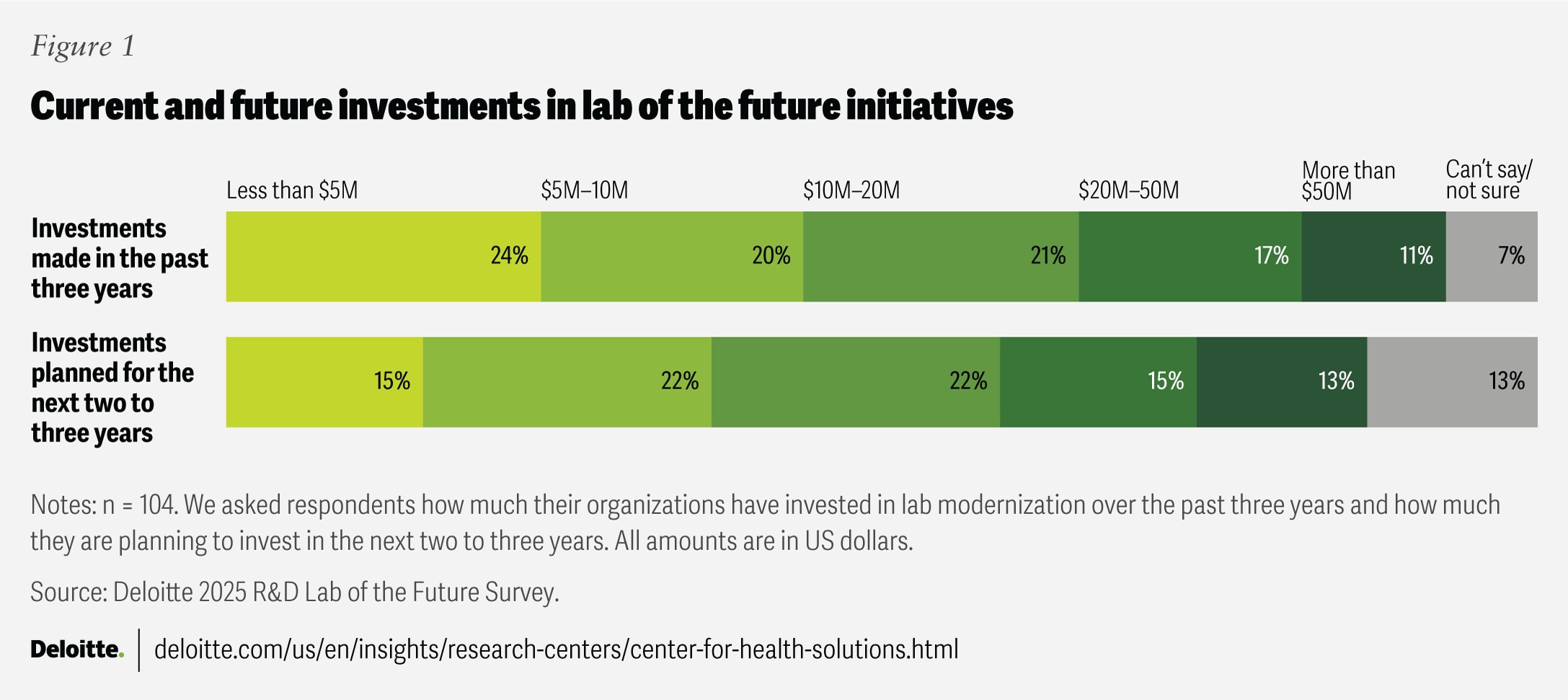
These investments appear to have led to tangible operational benefits for organizations. The survey results indicate that digitalization and automation, overall, are enhancing data quality, boosting research efficiency, and accelerating the pace of discovery. These operational gains demonstrate how modern lab technologies can not only reshape scientific workflows but also enable greater research productivity and improved data integrity.
As organizations continue to advance their lab modernization efforts, the cumulative effect of digitalization could unlock deeper scientific insights, shorten development timelines, and increase the probability of success for new therapies (figure 2).
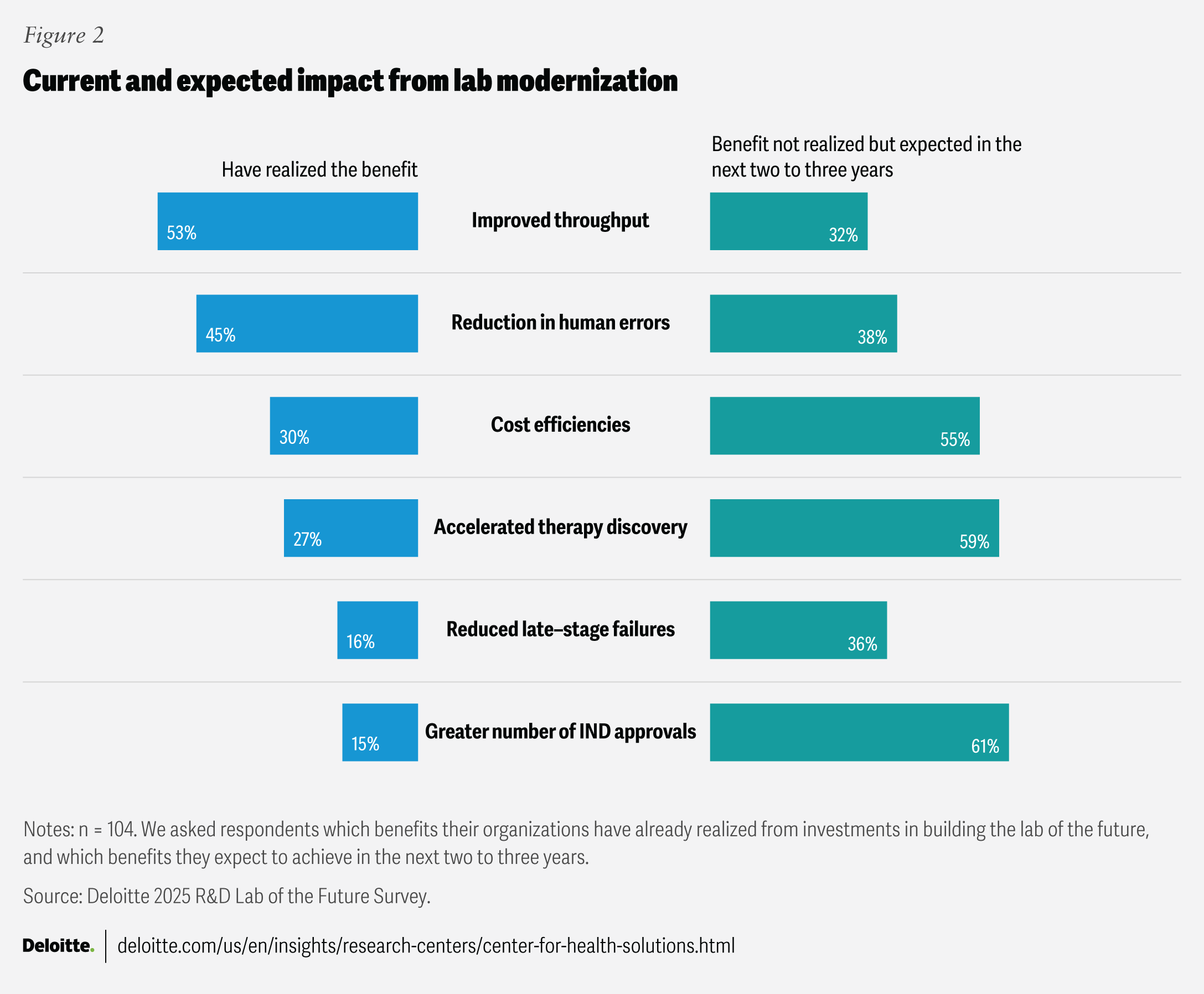
Building on the momentum of recent investments, the outlook for lab-of-the-future initiatives over the next two to three years appears to have potential. Surveyed R&D executives expressed optimism about the transformative potential of these investments, with nearly 60% expecting to see an increase in Investigational New Drug approvals and a faster pace of drug discovery. Furthermore, 80% of the executives surveyed indicated plans to sustain or increase their investment in lab modernization, reflecting an alignment between leadership optimism and broader R&D and business strategies.
Advancing along the digital maturity curve: From siloed systems to predictive R&D labs
As these initiatives gain traction, biopharma R&D labs are likely to evolve along a digital maturity curve—from basic, fragmented digital systems toward fully integrated, automated, and predictive environments. This progression represents more than just technological upgrades; it signals a fundamental shift in the way scientific research is conducted.10
An important early step for organizations is to assess their current level of digital maturity. This can enable more targeted investment and a clearer transformation roadmap.
According to the survey findings, R&D labs fall into six distinct maturity levels (figure 3), and maturity can vary widely even within the same organization. Specifically, 31% of respondents reported their R&D labs are currently “digitally siloed,” relying on multiple electronic lab notebooks and laboratory information management systems with limited integration or automation. And 34% of respondents have reached a “connected” stage, where data is centralized and partially integrated, and some automated lab processes are in place.
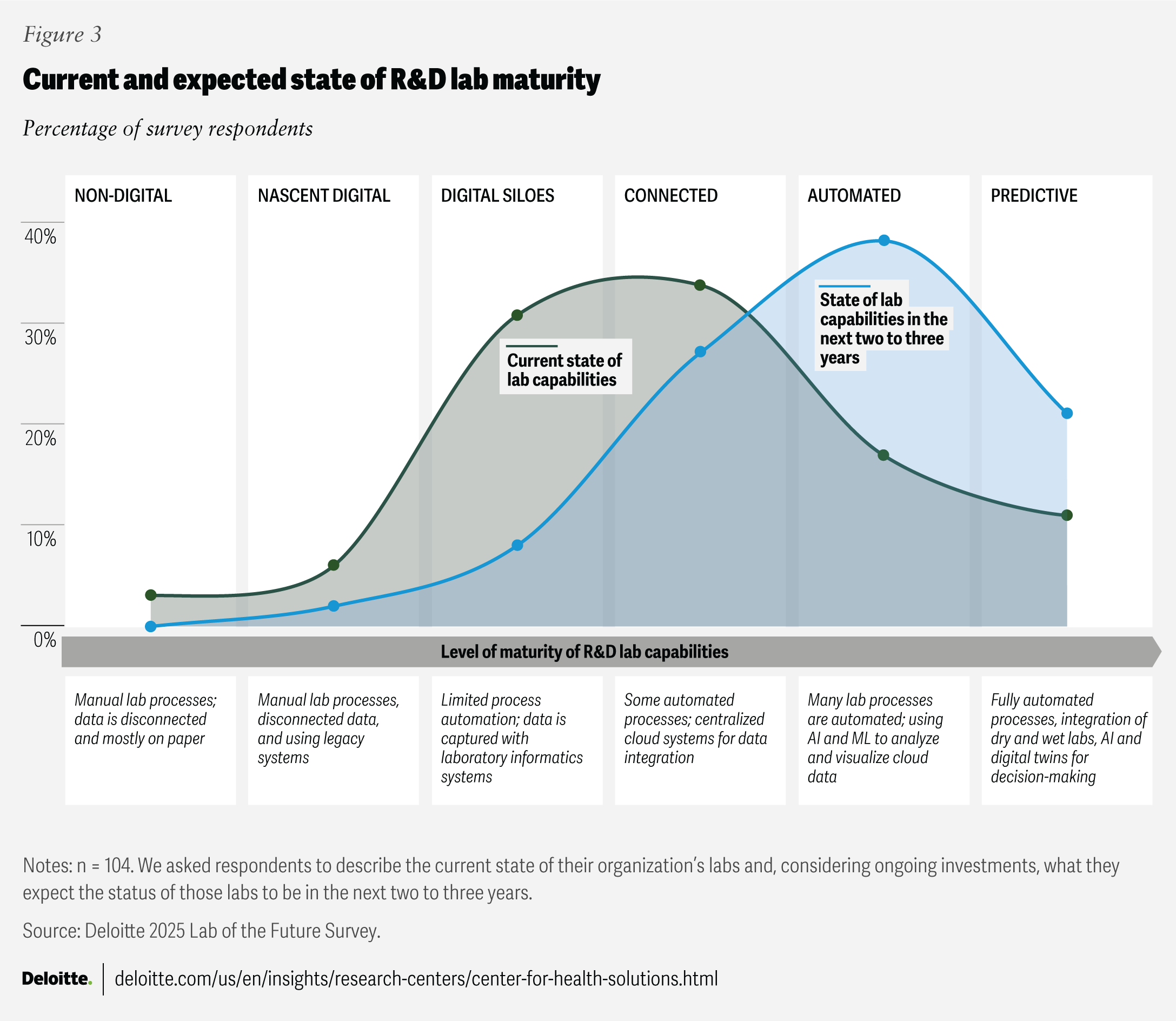
Looking ahead, 59% of respondents plan to continue investing in lab modernization over the next two to three years, with a focus on enhancing automation and predictive capabilities. Of these, 38% expect to embed AI and machine learning into lab operations and automate many processes.
Achieving a “predictive” state of lab maturity involves seamless integration between wet and dry lab environments, where AI, digital twins, and automation work together. In these advanced labs, insights from physical experiments and from in silico simulations inform each other in real time, guiding scientists toward optimal next steps. This could significantly shorten experimental cycle times by minimizing trial and error in experimentation and help identify high-quality, novel candidates for the pipeline.
While some organizations are beginning to realize these advanced capabilities, the R&D Lab of the Future Survey results confirm that the predictive state remains aspirational for most.11 As we shared earlier, just 11% of respondents indicated that their organization’s lab has reached this level of maturity, and 22% believe it is achievable within the next two to three years.
Considerations for maximizing the impact of lab of the future initiatives
The modern lab is not just a collection of tools and technologies; it is a digitally connected ecosystem where automation, advanced analytics, and intelligent systems work together to drive real-time collaboration among scientists, enhance efficiency, improve data quality and compliance, and accelerate scientific discovery.
To help fully capture these transformative benefits, biopharma organizations should consider approaching lab modernization as an integrated transformation and focus on four key areas: strategy, infrastructure, operations, and culture (figure 4).
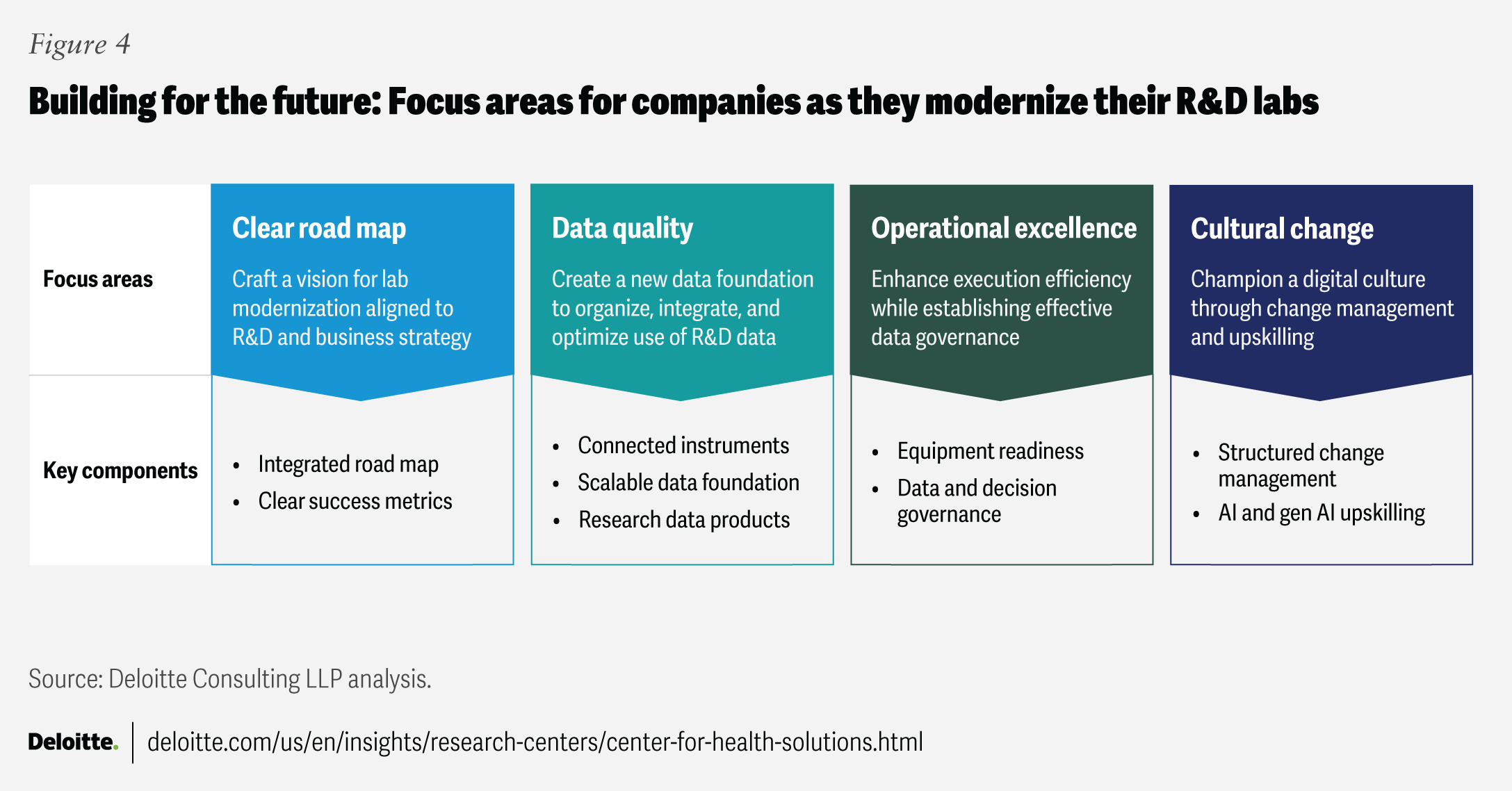
Establishing a comprehensive lab modernization roadmap aligned with R&D strategy
Improving R&D productivity can start with a clear vision for lab modernization that is closely aligned with broader R&D and business objectives. This vision should be translated into a detailed roadmap, linking investments and capabilities to defined outcomes, delivering both short-term gains and long-term transformational value.
Survey data reinforces the importance of this approach: more than 70% of respondents who reported reduced late-stage failure rates and increased IND approvals attributed these outcomes to lab-of-the-future investments, guided by a clear strategic roadmap.
In addition to a strong strategic roadmap, it is important for organizations to capture and clearly communicate the value generated from their lab-of-the-future investments to secure ongoing funding and leadership support. This appears to remain a challenge, with 32% of survey respondents identifying the demonstration of return on investment as one of the top three obstacles in their lab modernization efforts.
Establishing clear success measures—that are tied to quantitative metrics or KPIs such as reduced cycle times, improved portfolio decision-making, and fewer failed experiments—can help address this challenge. Yet only 37% of respondents indicated that their organizations currently use quantitative metrics to track ROI on lab investments, highlighting an opportunity for improvement.
Enhancing R&D data utility through a “research data product” focus
The effectiveness of a modern R&D lab generally depends on its ability to organize, integrate, and optimize the value of diverse data types. Eighty-four percent of survey respondents believe that adopting new technologies and analytical methods requires a robust data foundation. To help accomplish this, organizations can consider:
- Implementing connected instruments: This involves linking laboratory instruments and devices to enable seamless, automated data transfer into centralized cloud platforms.
- Building a scalable data foundation: This entails developing a flexible, modular architecture that supports the storage and management of various data modalities (such as structured, unstructured, image, and omics data). This should be complemented by workflows and ontologies designed for data interoperability and reusability across global R&D teams.
- Embracing research data products: This approach requires converting raw data into curated, reusable research data products (see sidebar, “What makes a ‘research data product’ key for modern R&D?”) that adhere to FAIR (Findable, Accessible, Interoperable, and Reusable) principles, accelerating scientific insight generation.
What makes a ‘research data product’ key for modern R&D?
A research data product is a high-quality, well-governed data asset for specific research needs. It’s built with a clear ontology, enriched with contextual metadata, and created through an automated, reproducible process (figure 5). These products are easily discoverable and intended for repeated use and sharing across teams.
For example, an RNA-seq data product standardizes gene expression data from multiple studies, enabling robust differential expression analysis. Similarly, a real-world data product might integrate electronic medical records with genomics data to support clinical research or train AI models.
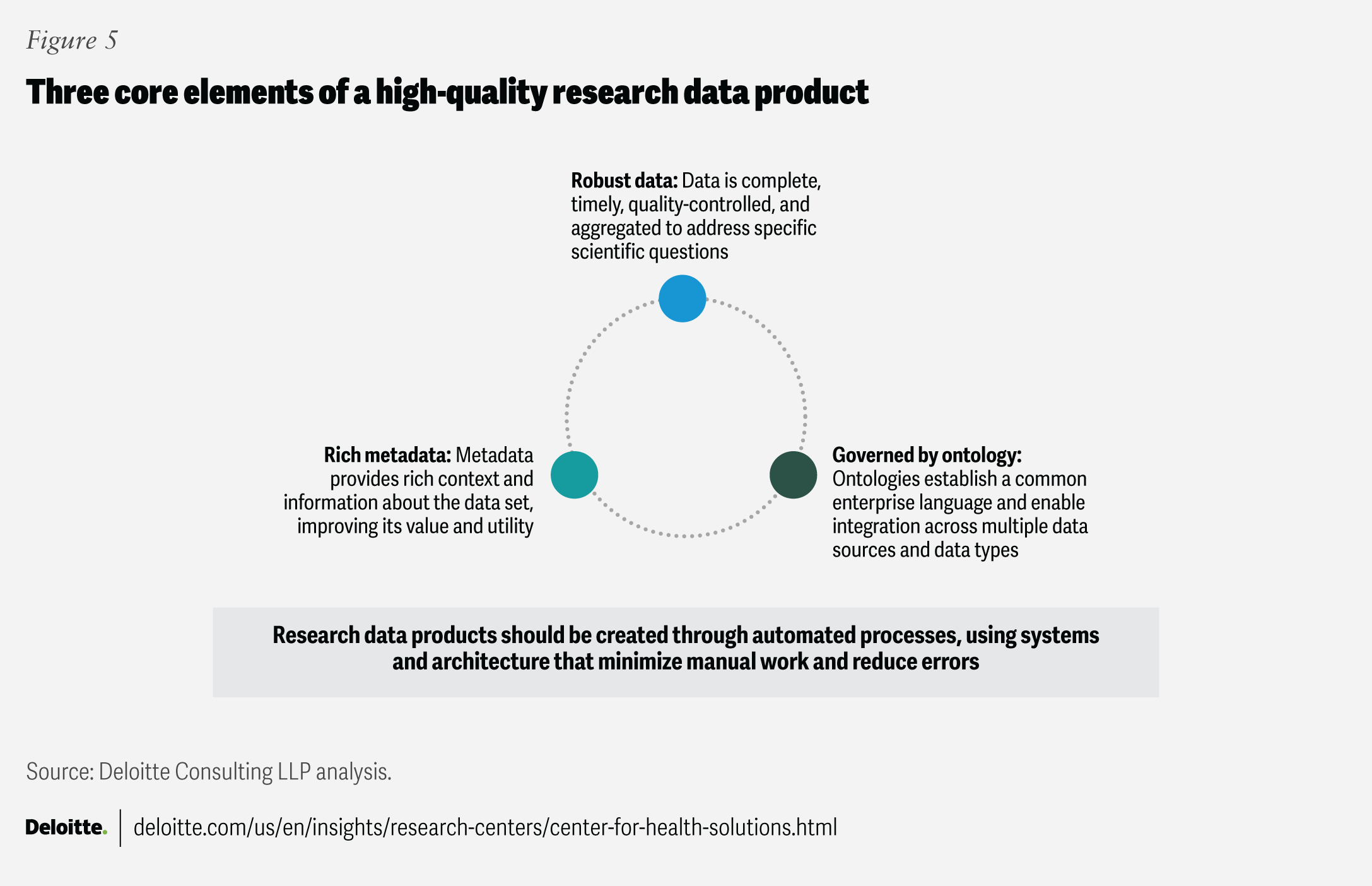
Creating and using research data products offers a range of benefits to R&D teams and scientists:
- Improved data quality and standardization: Research data products leverage standardized ontologies and terminology to create a consistent vocabulary across all included data sources. This approach can help reduce ambiguity, break down data silos, and improve data accuracy and reliability.
- Enhanced data discoverability and reusability: By incorporating rich metadata and standardized results, research data products can make it easier for scientists to search for and locate data across domains, enabling cross-study and multimodal analysis. The improved reusability and accessibility of these products also tends to allow information to be utilized more effectively.
- Increased efficiency and better decision-making: Research data products can enable researchers to focus on analysis by minimizing the time required for data cleaning and preparation. This shift tends to help support advanced analytics and machine learning, foster faster hypothesis development, accelerate insight generation, and lead to more informed decision-making.
Focusing on operational excellence and data governance
Operational inefficiencies—from idle equipment to missing consumables—can impede scientific progress by wasting valuable time that could be spent discovering the next breakthrough medicine. Organizations should consider treating lab equipment as strategic assets, using advanced analytics to track utilization, avoid unnecessary purchases, and optimize workflows.
Effective data governance is also key for organizations to achieve the desired benefits from their lab-of-the-future investments. Implementing continuous learning loops powered by AI and digital twins can allow organizations to systematically capture and analyze experimental insights, steering future research and optimizing portfolio management. Strong data governance can ensure these loops are supplied with reliable, high-quality data to enhance the reliability of insights and recommendations.
Championing cultural change to support digital transformation
Transforming a lab involves significant shifts in people, culture, and processes. Without structured change management, even leading tools risk underuse or resistance. About one-third (33%) of survey respondents identified scaling new technologies and processes as a major challenge, while 32% cited scientists’ hesitancy to adopt new ways of working as an obstacle.
These findings highlight the importance of engaging teams early, communicating the rationale for transformation, and empowering scientists with digital skills and ongoing support are essential for fostering trust and enabling sustained adoption of new technologies.
Seizing the innovation transformation opportunity
Biopharma organizations appear to be at a defining inflection point. The convergence of advanced technologies, scalable data infrastructure, and empowered scientific talent could present an opportunity to redefine the pace, precision, and productivity of R&D.
Lab-of-the-future initiatives are no longer experimental, they deliver measurable results and potentially could set new industry standards. Creating the digital foundation necessary for AI-driven drug discovery could lead to a deeper understanding of patients and the biological drivers of disease. Furthermore, these labs will likely enable R&D organizations to create feedback loops that retrain AI models on actual wet-lab outcomes, speeding up drug discovery and supporting sustainable pipeline replenishment.
To help position themselves for growth and value creation, biopharma organizations should consider making lab modernization a strategic priority. Those that scale digital transformation, create robust data foundations and governance, and lead with intentional change management can be well positioned to capitalize on AI and digital technologies to deliver the next wave of innovative therapies.
About the study
This analysis is based on survey responses from 104 R&D executives conducted in April 2025 across a diverse mix of biopharma organizations, ranging from early-stage startups to large, well-established companies involved in developing and manufacturing patented drugs and specialty therapies. Respondents included vice presidents, senior vice presidents, assistant vice presidents, senior scientists, directors, senior directors, and other R&D executives.
The survey aimed to evaluate investment trends in lab modernization, the adoption of digital technologies, realized value, and ongoing challenges. The survey also explored how digital investments have benefited R&D operations and the extent to which they are expected to impact lab efficiency and productivity.